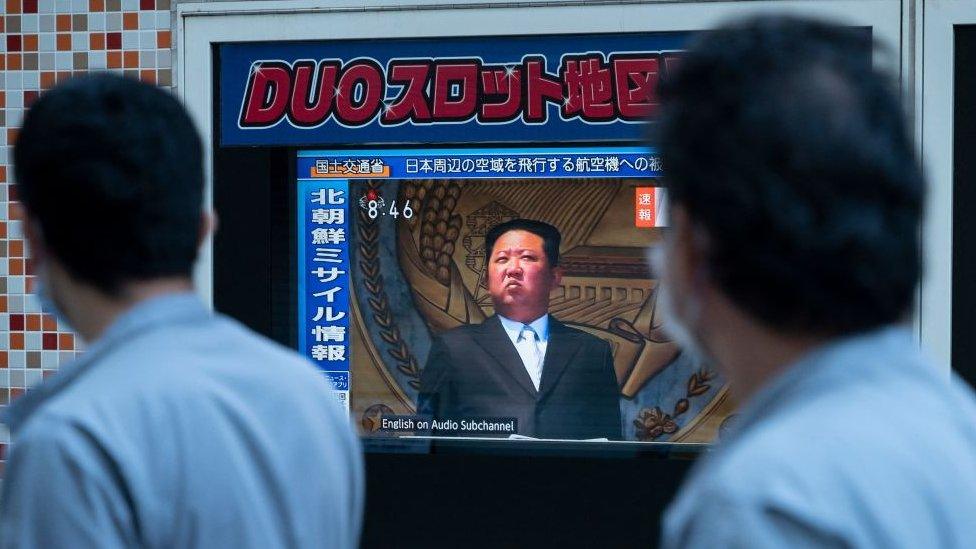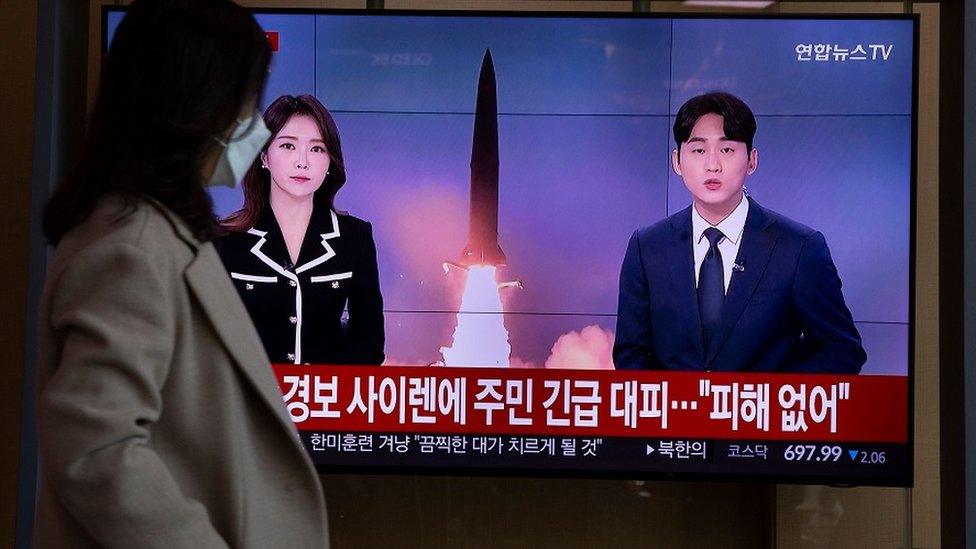North Korea: Kim Jong-un wants America's attention
- Published

It comes a day after a record number of missiles were launched from North Korea into seas off the coast of South Korea
It has been a confusing and nerve-wracking morning for people living in northern Japan.
At 07:50, air raid alarms went off across Miyagi and Yamagata prefectures and TV programmes were interrupted to tell people to take shelter. The Japanese coast guard said a missile fired from North Korea was heading over Japan. North Korean missiles have crossed Japan before - one did last month - but never this far south.
But the missile that was launched this morning never made it into Japanese airspace. According to South Korean military sources it failed mid-flight and fell back to earth, splashing down in the Sea of Japan/East Sea.
So, everyone please calm down and go back to your morning coffee. Well, no.
First, firing ballistic missiles towards your neighbours without warning, leaving them to guess where the missile will come down, is not normal behaviour. It is extremely provocative and dangerous, and completely outside the norms of international behaviour. It is a threat to aircraft and shipping. If the missiles break up it can rain debris on those below.
Second, this comes a day after a record number of missiles were launched from North Korea into seas off the coast of South Korea.
It also comes just days before crucial US midterm elections - and North Korean leader Kim Jong-un will be hoping that showing off his military capabilities will focus minds in the US capital.
So, what is Pyongyang up to?
North Korea is deliberately ramping up tensions with its neighbours. Analysts think it is building to something bigger, such as a nuclear test, or a full long-range ballistic missile test out in to the Pacific, or both.
There is a political objective to all this noise. It's a pattern Pyongyang used in 2010 and again in 2017. First, ramp up tensions to a frightening level, then call for engagement and concessions from South Korea, Japan and the United States. Pyongyang is almost certainly doing the same again now.
But Mr Kim has a second objective. The North is still far from perfecting its missile technology.
After the missile is launched into space, the warhead separates and comes back towards Earth in a "re-entry vehicle". This must be able to withstand the enormous heat and pressure generated as it plunges through the atmosphere.
In previous tests it appears that North Korea's re-entry vehicles have failed. So, Pyongyang needs to keep on testing to perfect its technology.
Thursday's test appears to have flown on what is called a "lofted trajectory", flying high up in to space - about 2,000km (1,242 miles) - and then steeply back down. It is possible this was done to test a long-range missile, without flying it over Japan. If today's test was indeed another failure - it only demonstrates how far Pyongyang still has to go.
But the ultimate aim is not just to threaten South Korea and Japan. North Korea can do that already.
It is to threaten the US with a nuclear-capable intercontinental ballistic missile (ICBM). Today's test will certainly have shaken those who heard the sirens go off.
But if North Korea's intent is to cow Japan, it is having the opposite effect. Pyongyang's missile tests, along with China's recent threats to Taiwan, are having a profound impact on Japanese politics. For decades Japan's right have called for the post-war pacifist constitution to be scrapped and the country to re-arm.
Until now most ordinary Japanese have said no.
But that is changing, and now the security hawks have all the justification they need to push ahead. Next month the government will propose doubling the defence budget over the next decade, and the acquisition of long-range strike weapons.
Reports suggest Japan is negotiating the purchase of hundreds of Tomahawk cruise missiles from the US. That would mean for the first time since World War II Japan would have the ability to strike at targets deep inside China and North Korea.
Related topics
- Published2 November 2022

- Published26 October 2022

- Published5 September 2023
